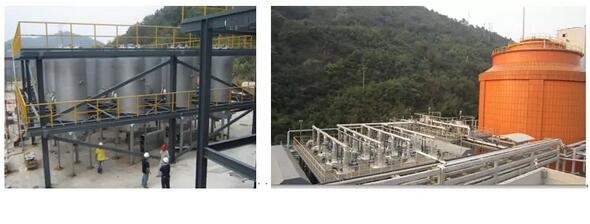Anaerobic digestion of sludge refers to the process of decomposing biodegradable organic matter in sludge into carbon dioxide, methane and water by facultative bacteria and anaerobic bacteria under anaerobic conditions to stabilize the sludge. It is one of the commonly used means of sludge reduction and stabilization. Anaerobic digestion of sludge has the advantages of reducing sludge volume, stabilizing sludge properties, and generating methane gas.
Traditional sludge anaerobic digestion has the disadvantages of slow reaction, low degradation rate of organic matter and low methane production, which limits the advantages of sludge anaerobic digestion technology. According to Bryant’s three-stage theory, sludge hydrolysis is the rate-limiting step in sludge anaerobic digestion. Therefore, since the 1970s, various sludge anaerobic digestion enhancement technologies including high temperature thermal hydrolysis, ultrasonic pretreatment, alkaline hydrolysis pretreatment and ozone pretreatment have been studied. The cell wall of the sludge transfers the intracellular organic matter from the solid phase to the liquid phase, promotes sludge hydrolysis, and improves the anaerobic digestion effect of the sludge.
As the amount of sludge in various countries continues to increase and the demand for energy and the quality of treated sludge continue to increase, some of the original sludge anaerobic digestion facilities are facing expansion and transformation. Sludge pretreatment technology can improve the anaerobic digestion effect of sludge, improve sludge dewatering effect and increase biogas production. It can replace the benefit of digestive tank expansion to a certain extent, so it has been widely used in research and application. Among them, the high-temperature thermal hydrolysis technology of sludge is relatively mature. At present, this technology has developed various processes such as Cambi thermal hydrolysis, Biothelysis thermal hydrolysis and Monsal enzymatic hydrolysis, which have been popularized and applied in Europe in recent years, Norway, the United Kingdom and Australia has successfully applied cases.
In view of the limitation of low solid content of traditional sludge anaerobic digestion, research on high-solid sludge anaerobic digestion technology has also become a hot spot. The advantage of high-solids sludge anaerobic digestion is that the biogas production efficiency is higher than the traditional anaerobic digestion, because the solid content of the sludge is greatly increased, and the amount of organic matter in the sludge anaerobic digestion tank can be contacted and digested. As a result, the gas production efficiency and processing load are also increased. At present, a variety of high-solid sludge anaerobic digestion technologies have been developed in foreign countries, and have been applied in practical projects. For example, the Finnish HLAD process controls the sludge solid content into the pre-reaction tank by 10% to 15%. Gas production efficiency is 30% higher than traditional sludge anaerobic digestion.
Advantages of sludge anaerobic digestion technology:
- The sludge anaerobic digestion process can kill some pathogenic bacteria and parasite eggs, so that the sludge is stabilized and not rancid.
- The anaerobic digestion process of the sludge produces biogas, which can effectively recover the sludge biomass energy.
- Sludge anaerobic digestion can degrade 35%~50% volatile solids in sludge, reduce the dry solids of sludge, and help reduce the cost of subsequent sludge treatment and disposal. At the same time, sludge anaerobic digestion helps to improve sludge dewatering performance, and the sludge volume can be further reduced after dewatering.
Disadvantages of sludge anaerobic digestion technology:
- Maintaining the temperature required for anaerobic digestion of sludge requires a significant amount of heat.
- Sludge anaerobic digestion process has a long residence time, usually reaching 20~30d, resulting in a large volume of sludge anaerobic digestion tank and complicated operation and management.
- Methanogenic bacteria require high environmental conditions, and must be cultured in the start-up phase, with initial initial debugging time.
- The sludge moisture content after sludge anaerobic digestion is still high, and must be followed up. Commonly used methods are heat drying and deep dewatering.



